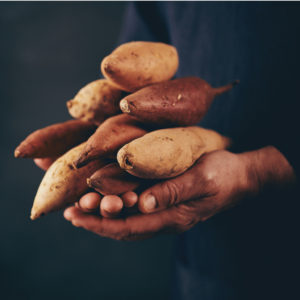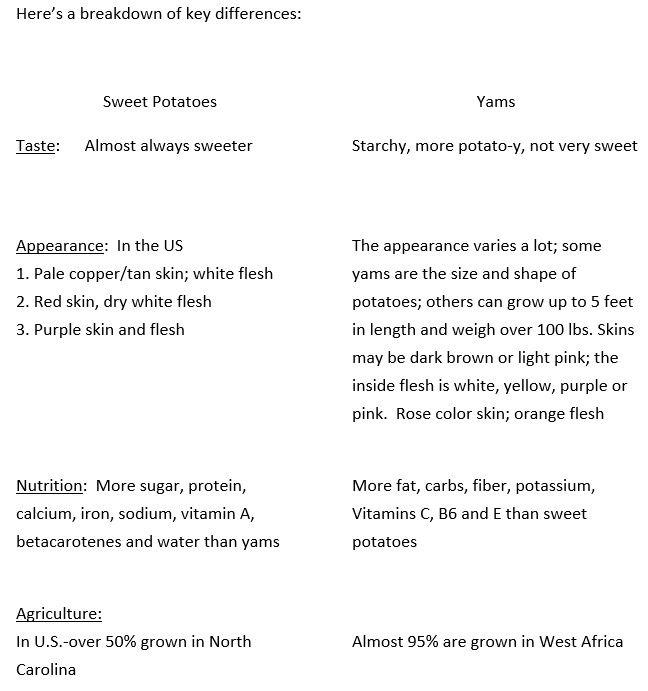 When it comes to yams and sweet potatoes…. I admit to what seems like group confusion—me, other vegetable shoppers, produce managers, chefs and my mother.
When it comes to yams and sweet potatoes…. I admit to what seems like group confusion—me, other vegetable shoppers, produce managers, chefs and my mother.
The confusion starts with the problem that in the United States, the terms “yam” and “sweet potato” are used interchangeably, but they are actually completely different vegetables. Yams are starchy with a dry whitish interior and have that rough, bark like brown exterior. They are typically 6-10 inches long in my grocery stores but can grow up to 45 feet long and are eaten in parts of Latin America, West Africa, the Caribbean, and Asia. Sweet potatoes on the other hand are a vegetable of the New World and have a softer, reddish skin, and are a bit darker with creamy texture on the inside. They can vary from white to orange to even purple. Most of our American supermarkets are selling us sweet potatoes, not yams. You might have to go to an African market to find a yam that has been imported from Ghana or another far away country.
That sweet tasting bright colored root vegetable I thought was a yam, is actually a sweet potato. That other whitish interior potato like root vegetable that I thought was a sweet potato— is a sweet potato, just a different variety than the bright orange interior with reddish skinned exterior. A true yam is a starchy edible root, low in beta carotene and of the Dioscorea genus.
That orange colored flesh, that I and my mom thought were yams, were introduced to the United States several decades ago. Today, the U.S. Department of Agriculture requires labels with the term “yam”, to be accompanied by the term “sweet potato”.
A bit of history: Yams are an important part of West African diets and as stated above, about 95% of the yams in the world come from West African. When European slave traders captured the peoples of that region and crossed the Middle Passage, they packed the ships with yams and black-eyed peas to feed their captives. In the Americas at the time, where yams were not much available, sweet potatoes, which had come from Central America with Christopher Columbus, took the place of yams. As I understand it, yams had a spiritual and cultural significance and heritage to the enslaved peoples forced to live in the U.S. In West Africa, they had celebrations of the yam harvest, calling it the king of crops, with offerings made to the spirits – their ancestors. Food writers and historians have said that the fact that we perpetuate the confusion of sweet potatoes and yams is a testament to these deep West African food traditions underpinning American cuisine. They say further, “the mix-up has roots in the structural racism that built the country, but the use of sweet potatoes as yams by African-Americans is ultimately a result of resilience and innovation.”
This Thanksgiving…it is likely you enjoyed your sweet potatoes, no matter the color…unless you venture to an African market and partake in the true tradition of yams. I think I’ll make an effort to go searching for this root vegetable and partake a bit in the heritage and honoring of the peoples of that region…..as well as ponder the past history of the United States and the horror of slavery. And we haven’t even yet gotten to the true history of Thanksgiving and how the indigenous peoples of the east coast were gracious and generous to the visiting white arrivals from Europe…offering them food and teaching them to eat wild turkey and grow plants in the new climate and land that the whites were not surviving well in at all…only to then experience the horror of new diseases, greed, disrespect and violence of these visitors whom they welcomed and helped. The legacies of slavery and attempted genocide live on in oh so many ways in our country. I will be thinking about these things around these coming holidays in particular. I invite you to, as well.


